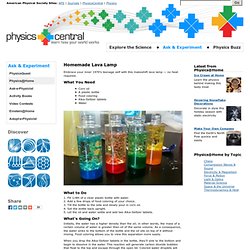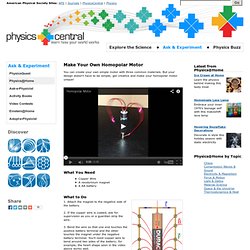

Pendulum Waves. Homemade Lava Lamp. Embrace your inner 1970’s teenage self with this makeshift lava lamp — no heat required.

What You Need Corn oilA plastic bottleFood coloringAlka-Seltzer tabletsWater What to Do 1. Fill 1/4th of a clear plastic bottle with water. 2. What's Going On? Initially, the water has a higher density than the oil; in other words, the mass of a certain volume of water is greater than oil of the same volume. When you drop the Alka-Seltzer tablets in the bottle, they’ll sink to the bottom and begin to dissolve in the water.
Apply It! While traditional lava lamps require liquids of different densities, their densities are much closer. As the liquid expands, the volume of the liquid increases, and its density decreases. -Jamie Garrett. 14 YouTube Tutorials for Science Experiments. 15 Science Experiments You Can Do With Your Kids. By Therese Oneill Time to get messy, light some stuff on fire, and use food products in ways they were never intended!

Parents and teachers across the internet have found fun ways to teach kids science, and have documented the experiments for the rest of us. Here are 15 hands-on science lessons that will stick in a kid’s brain far longer than anything they get from a textbook. 1. Lemony Sudsy Eruptions @ Blog Me Mom Fun Quotient: A much less stinky take on the trusty vinegar and baking soda eruptions. Teaches: The baking soda base and the citric acid create an endothermic reaction while releasing carbon dioxide in bubble form. 2.
TaxFix.co.uk Fun Quotient: Holy crud—you’re burning money! Teaches: Combustion, or what a fire likes to eat. 3. Fun Quotient: It makes pretty rocks you can eat! Teaches: Water evaporates, the sugar crystals don’t. 4. Fun Quotient: They get to use sharp things and electricity, which is Frankenstein-level cool. Teaches: Electromagnets are everywhere. 5. Make Your Own Homopolar Motor. You can create your own simple motor with three common materials.

But your design doesn't have to be simple; get creative and make your homopolar motor unique! What You Need Copper WireA neodymium magnetA AA battery What to Do The current flows downward in both wires, and the magnetic field is pointing approximately outward when it reaches the wires on the side. Glowing Jell-O Physics. Jell-O — the jiggly dessert favored by kids everywhere — comes in a variety of flavors and bright, neon colors.

Once the lights go off, however, typical Jell-O loses its characteristic colors. But with a small change in the recipe, you can make this treat glow under a black light! Here's your guide to fluorescent Jell-O: The tonic water Jell-O under normal light (top) and a UV light (bottom). What You Need Jell-O (flavor of choice)Tonic waterA clear glass bowl or clear cupsA Black light What to Do 1.
What's Going On? Ultra-violet light has a higher frequency and lower wavelength than the visible light you experience everyday. For the experiment, the tonic water added to the Jell-O mix contains quinine — a substance that has fluorescent properties. Apply It! What makes this Jell-O special? More Information - Jamie Garrett.